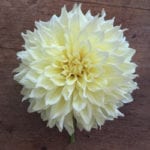All About Dahlias

Dahlia is a perennial plant native to Mexico; bushy, tuberous, herbaceous and revered for their amazing beauty. A member of the Asteraceae (or Compositae), dicotyledonous plants, related species include the Sunflower, Daisy, Chrysanthemum, and Zinnia. There are 42 species of dahlia, with hybrids commonly grown as garden plants. Flower forms are variable, with one head per stem; these can be as small as 2″/5cm in diameter or up to 12″/ 30cm (The dinner plate variety).
Dahlias grow naturally in climates which are frost free (USDA Zone 8), and they are not adapted to withstand below freezing temperatures. But their tuberous nature enables them to survive long periods of dormancy. This characteristic means that gardeners in temperate climates with frosts can grow dahlias successfully, as long as the tubers are extracted from the ground and then stored over the winter in a frost-free environment. Planting the tubers quite deep can also provide frost protection. When in growth season, modern dahlia hybrids require free-draining soil, and thrive in maximum sunlight. Taller cultivars typically require some form of staking as they grow, and all garden dahlias need deadheading regularly, once flowering commences, to continue blooming throughout the entire season.
You must be logged in to post a comment.